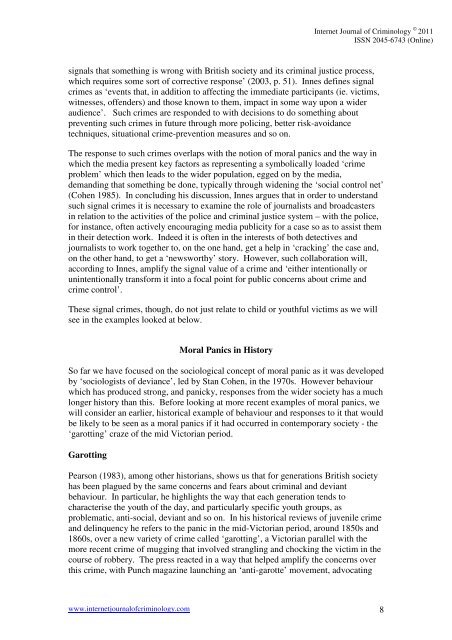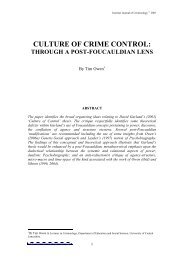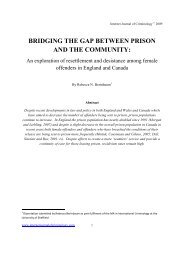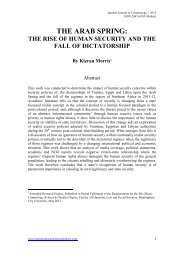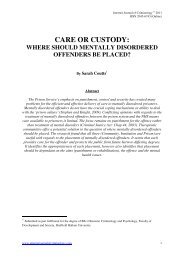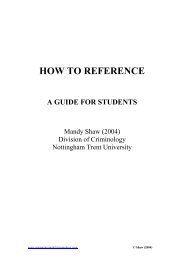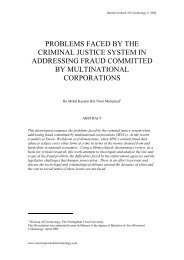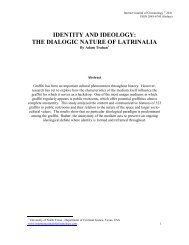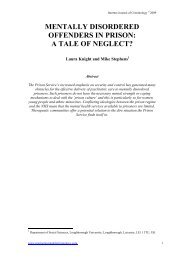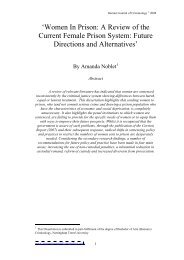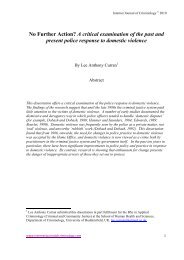moral panics and the british media - Internet Journal of Criminology
moral panics and the british media - Internet Journal of Criminology
moral panics and the british media - Internet Journal of Criminology
Create successful ePaper yourself
Turn your PDF publications into a flip-book with our unique Google optimized e-Paper software.
<strong>Internet</strong> <strong>Journal</strong> <strong>of</strong> <strong>Criminology</strong> © 2011<br />
ISSN 2045-6743 (Online)<br />
signals that something is wrong with British society <strong>and</strong> its criminal justice process,<br />
which requires some sort <strong>of</strong> corrective response’ (2003, p. 51). Innes defines signal<br />
crimes as ‘events that, in addition to affecting <strong>the</strong> im<strong>media</strong>te participants (ie. victims,<br />
witnesses, <strong>of</strong>fenders) <strong>and</strong> those known to <strong>the</strong>m, impact in some way upon a wider<br />
audience’. Such crimes are responded to with decisions to do something about<br />
preventing such crimes in future through more policing, better risk-avoidance<br />
techniques, situational crime-prevention measures <strong>and</strong> so on.<br />
The response to such crimes overlaps with <strong>the</strong> notion <strong>of</strong> <strong>moral</strong> <strong>panics</strong> <strong>and</strong> <strong>the</strong> way in<br />
which <strong>the</strong> <strong>media</strong> present key factors as representing a symbolically loaded ‘crime<br />
problem’ which <strong>the</strong>n leads to <strong>the</strong> wider population, egged on by <strong>the</strong> <strong>media</strong>,<br />
dem<strong>and</strong>ing that something be done, typically through widening <strong>the</strong> ‘social control net’<br />
(Cohen 1985). In concluding his discussion, Innes argues that in order to underst<strong>and</strong><br />
such signal crimes it is necessary to examine <strong>the</strong> role <strong>of</strong> journalists <strong>and</strong> broadcasters<br />
in relation to <strong>the</strong> activities <strong>of</strong> <strong>the</strong> police <strong>and</strong> criminal justice system – with <strong>the</strong> police,<br />
for instance, <strong>of</strong>ten actively encouraging <strong>media</strong> publicity for a case so as to assist <strong>the</strong>m<br />
in <strong>the</strong>ir detection work. Indeed it is <strong>of</strong>ten in <strong>the</strong> interests <strong>of</strong> both detectives <strong>and</strong><br />
journalists to work toge<strong>the</strong>r to, on <strong>the</strong> one h<strong>and</strong>, get a help in ‘cracking’ <strong>the</strong> case <strong>and</strong>,<br />
on <strong>the</strong> o<strong>the</strong>r h<strong>and</strong>, to get a ‘newsworthy’ story. However, such collaboration will,<br />
according to Innes, amplify <strong>the</strong> signal value <strong>of</strong> a crime <strong>and</strong> ‘ei<strong>the</strong>r intentionally or<br />
unintentionally transform it into a focal point for public concerns about crime <strong>and</strong><br />
crime control’.<br />
These signal crimes, though, do not just relate to child or youthful victims as we will<br />
see in <strong>the</strong> examples looked at below.<br />
Moral Panics in History<br />
So far we have focused on <strong>the</strong> sociological concept <strong>of</strong> <strong>moral</strong> panic as it was developed<br />
by ‘sociologists <strong>of</strong> deviance’, led by Stan Cohen, in <strong>the</strong> 1970s. However behaviour<br />
which has produced strong, <strong>and</strong> panicky, responses from <strong>the</strong> wider society has a much<br />
longer history than this. Before looking at more recent examples <strong>of</strong> <strong>moral</strong> <strong>panics</strong>, we<br />
will consider an earlier, historical example <strong>of</strong> behaviour <strong>and</strong> responses to it that would<br />
be likely to be seen as a <strong>moral</strong> <strong>panics</strong> if it had occurred in contemporary society - <strong>the</strong><br />
‘garotting’ craze <strong>of</strong> <strong>the</strong> mid Victorian period.<br />
Garotting<br />
Pearson (1983), among o<strong>the</strong>r historians, shows us that for generations British society<br />
has been plagued by <strong>the</strong> same concerns <strong>and</strong> fears about criminal <strong>and</strong> deviant<br />
behaviour. In particular, he highlights <strong>the</strong> way that each generation tends to<br />
characterise <strong>the</strong> youth <strong>of</strong> <strong>the</strong> day, <strong>and</strong> particularly specific youth groups, as<br />
problematic, anti-social, deviant <strong>and</strong> so on. In his historical reviews <strong>of</strong> juvenile crime<br />
<strong>and</strong> delinquency he refers to <strong>the</strong> panic in <strong>the</strong> mid-Victorian period, around 1850s <strong>and</strong><br />
1860s, over a new variety <strong>of</strong> crime called ‘garotting’, a Victorian parallel with <strong>the</strong><br />
more recent crime <strong>of</strong> mugging that involved strangling <strong>and</strong> chocking <strong>the</strong> victim in <strong>the</strong><br />
course <strong>of</strong> robbery. The press reacted in a way that helped amplify <strong>the</strong> concerns over<br />
this crime, with Punch magazine launching an ‘anti-garotte’ movement, advocating<br />
www.internetjournal<strong>of</strong>criminology.com 8


